Non-Functional Requirements and SDLC for Cloud Based Solutions Report
VerifiedAdded on 2020/03/23
|13
|2801
|83
Report
AI Summary
This report analyzes cloud-based solutions for Headspace, an Australian company focusing on mental health. It begins by outlining the non-functional requirements critical to cloud-based applications, including critical system qualities, system interfaces, user interface requirements, and system constraints. The report then compares functional and non-functional requirements, highlighting aspects like usability, reliability, performance, and security. It reviews cloud-based solutions, exploring their strengths (cost savings, reliability, manageability, and strategic edge) and weaknesses (downtime, security concerns, and vendor lock-in). The report emphasizes the importance of data security, especially concerning HIPAA and HITECH compliance. Finally, it recommends an Adaptive SDLC approach, such as Scrum or XP, for the Headspace project, citing its focus on customer satisfaction, frequent delivery of working software, and adaptability to changing requirements. The report concludes with a recommendation for the Adaptive SDLC approach for the project.
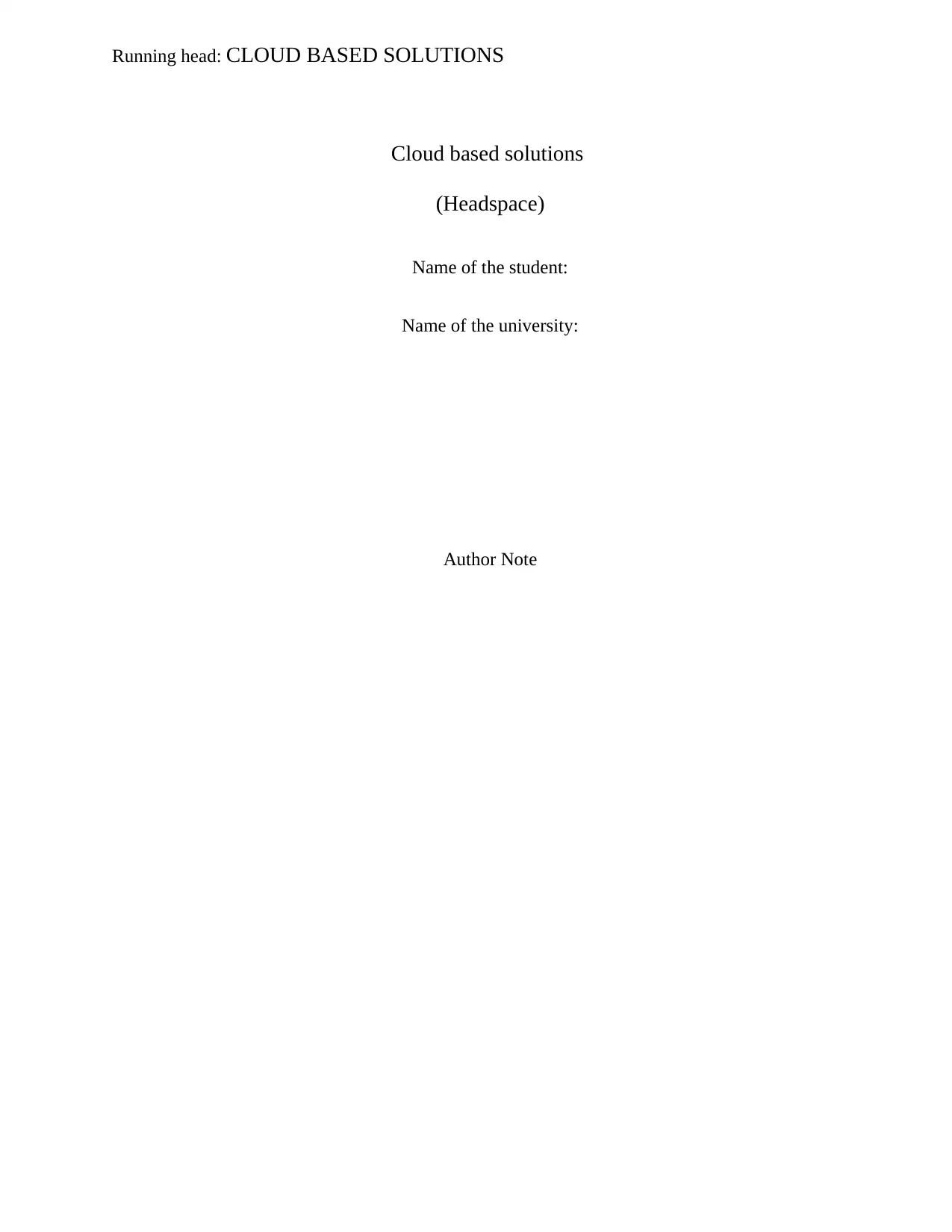
Running head: CLOUD BASED SOLUTIONS
Cloud based solutions
(Headspace)
Name of the student:
Name of the university:
Author Note
Cloud based solutions
(Headspace)
Name of the student:
Name of the university:
Author Note
Paraphrase This Document
Need a fresh take? Get an instant paraphrase of this document with our AI Paraphraser
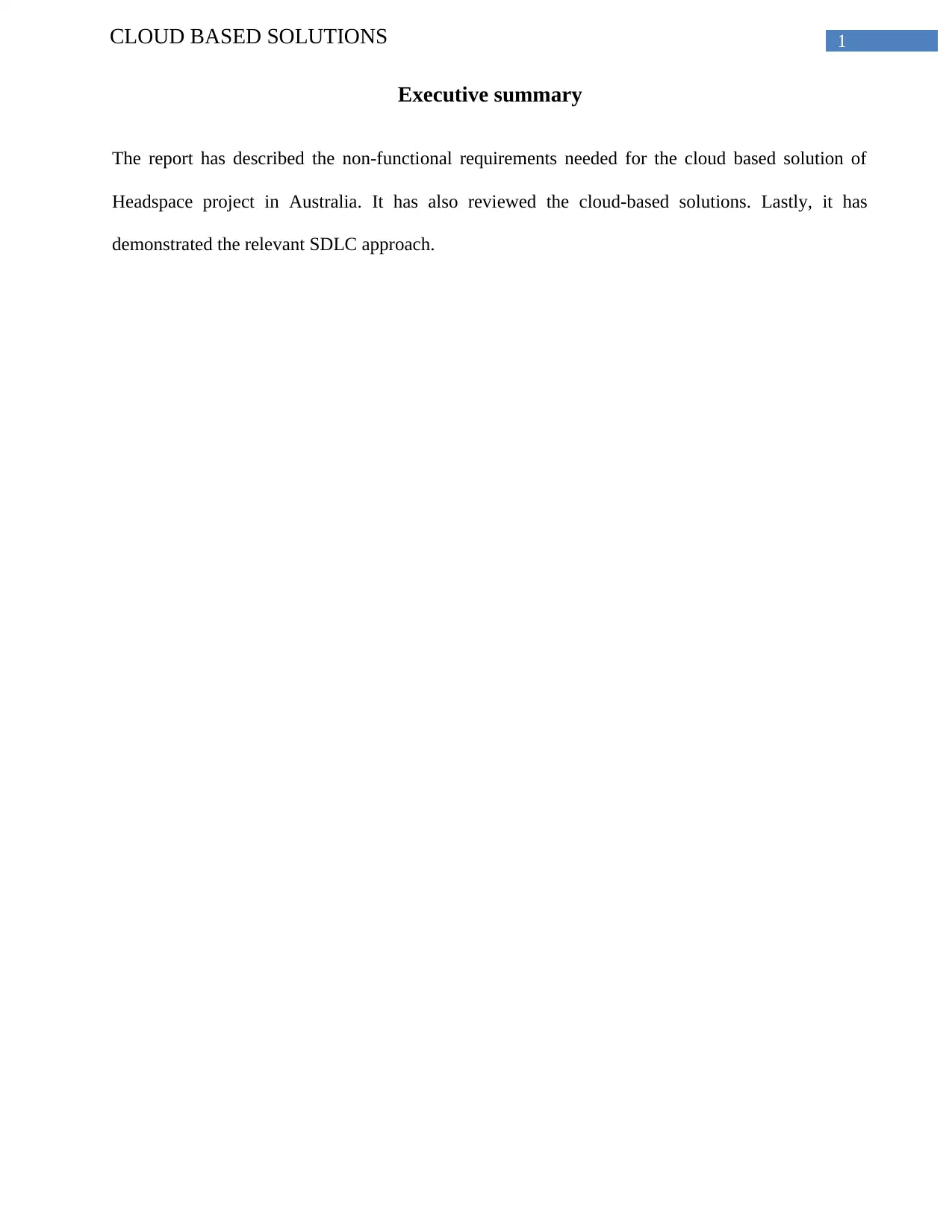
1CLOUD BASED SOLUTIONS
Executive summary
The report has described the non-functional requirements needed for the cloud based solution of
Headspace project in Australia. It has also reviewed the cloud-based solutions. Lastly, it has
demonstrated the relevant SDLC approach.
Executive summary
The report has described the non-functional requirements needed for the cloud based solution of
Headspace project in Australia. It has also reviewed the cloud-based solutions. Lastly, it has
demonstrated the relevant SDLC approach.
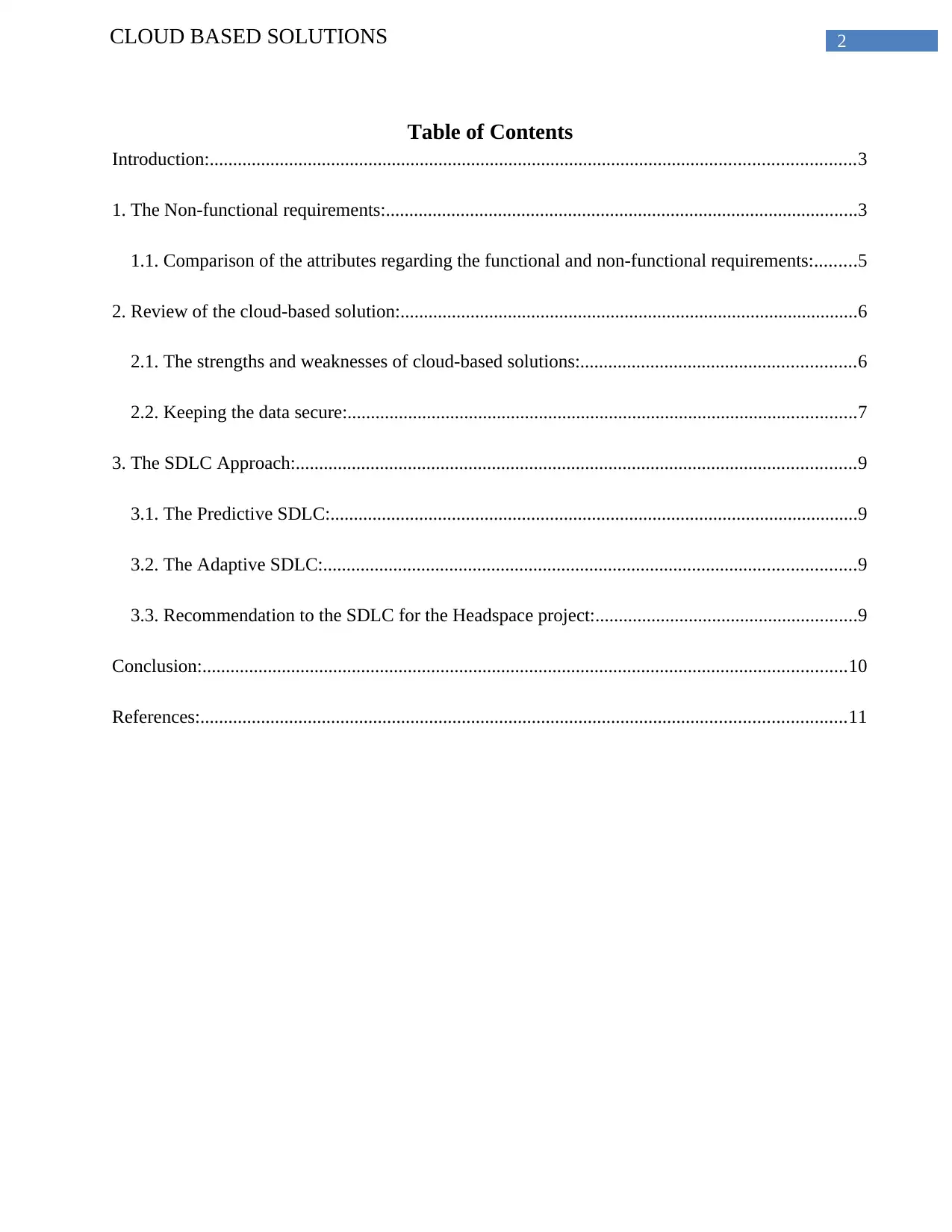
2CLOUD BASED SOLUTIONS
Table of Contents
Introduction:..........................................................................................................................................3
1. The Non-functional requirements:.....................................................................................................3
1.1. Comparison of the attributes regarding the functional and non-functional requirements:.........5
2. Review of the cloud-based solution:..................................................................................................6
2.1. The strengths and weaknesses of cloud-based solutions:...........................................................6
2.2. Keeping the data secure:.............................................................................................................7
3. The SDLC Approach:........................................................................................................................9
3.1. The Predictive SDLC:.................................................................................................................9
3.2. The Adaptive SDLC:..................................................................................................................9
3.3. Recommendation to the SDLC for the Headspace project:........................................................9
Conclusion:..........................................................................................................................................10
References:..........................................................................................................................................11
Table of Contents
Introduction:..........................................................................................................................................3
1. The Non-functional requirements:.....................................................................................................3
1.1. Comparison of the attributes regarding the functional and non-functional requirements:.........5
2. Review of the cloud-based solution:..................................................................................................6
2.1. The strengths and weaknesses of cloud-based solutions:...........................................................6
2.2. Keeping the data secure:.............................................................................................................7
3. The SDLC Approach:........................................................................................................................9
3.1. The Predictive SDLC:.................................................................................................................9
3.2. The Adaptive SDLC:..................................................................................................................9
3.3. Recommendation to the SDLC for the Headspace project:........................................................9
Conclusion:..........................................................................................................................................10
References:..........................................................................................................................................11
⊘ This is a preview!⊘
Do you want full access?
Subscribe today to unlock all pages.

Trusted by 1+ million students worldwide
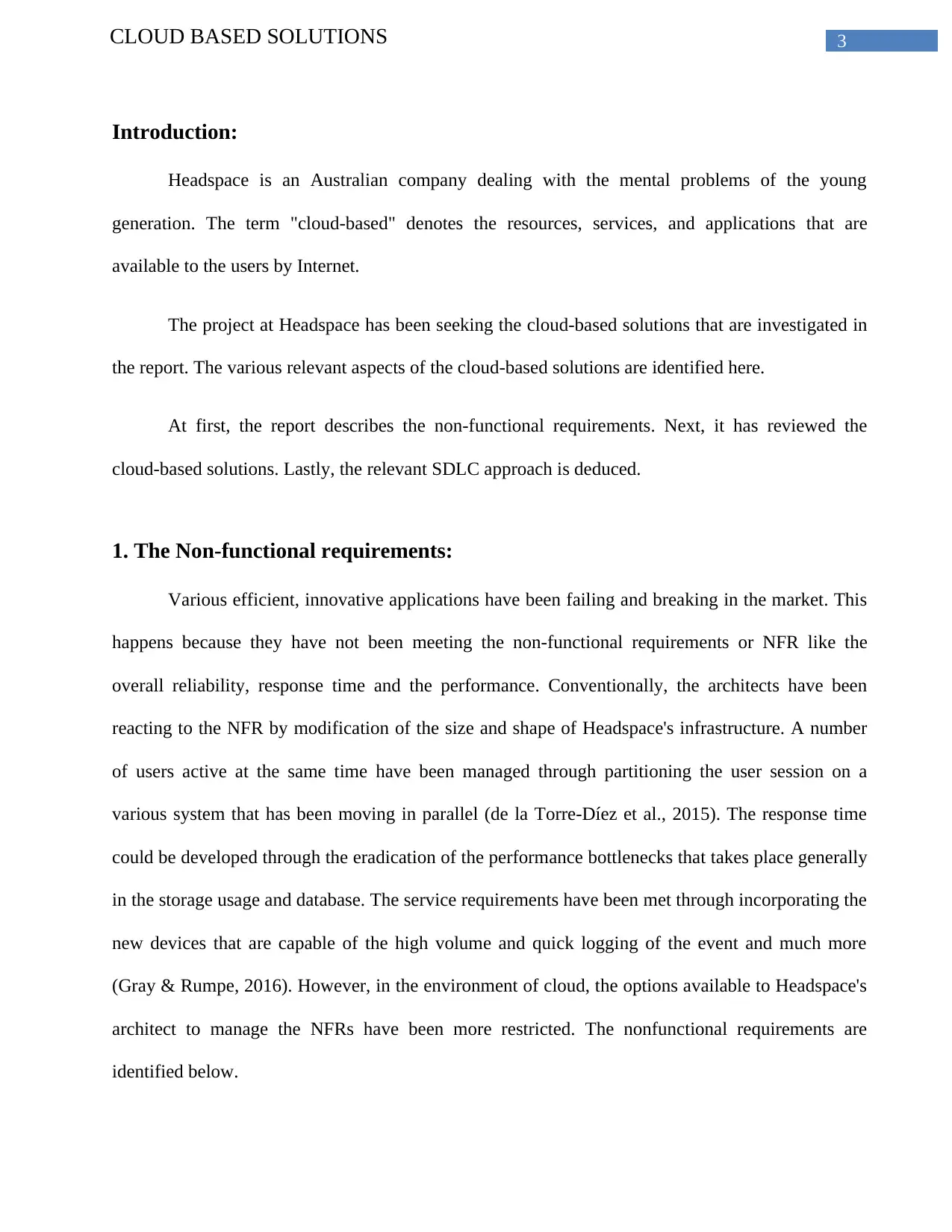
3CLOUD BASED SOLUTIONS
Introduction:
Headspace is an Australian company dealing with the mental problems of the young
generation. The term "cloud-based" denotes the resources, services, and applications that are
available to the users by Internet.
The project at Headspace has been seeking the cloud-based solutions that are investigated in
the report. The various relevant aspects of the cloud-based solutions are identified here.
At first, the report describes the non-functional requirements. Next, it has reviewed the
cloud-based solutions. Lastly, the relevant SDLC approach is deduced.
1. The Non-functional requirements:
Various efficient, innovative applications have been failing and breaking in the market. This
happens because they have not been meeting the non-functional requirements or NFR like the
overall reliability, response time and the performance. Conventionally, the architects have been
reacting to the NFR by modification of the size and shape of Headspace's infrastructure. A number
of users active at the same time have been managed through partitioning the user session on a
various system that has been moving in parallel (de la Torre-Díez et al., 2015). The response time
could be developed through the eradication of the performance bottlenecks that takes place generally
in the storage usage and database. The service requirements have been met through incorporating the
new devices that are capable of the high volume and quick logging of the event and much more
(Gray & Rumpe, 2016). However, in the environment of cloud, the options available to Headspace's
architect to manage the NFRs have been more restricted. The nonfunctional requirements are
identified below.
Introduction:
Headspace is an Australian company dealing with the mental problems of the young
generation. The term "cloud-based" denotes the resources, services, and applications that are
available to the users by Internet.
The project at Headspace has been seeking the cloud-based solutions that are investigated in
the report. The various relevant aspects of the cloud-based solutions are identified here.
At first, the report describes the non-functional requirements. Next, it has reviewed the
cloud-based solutions. Lastly, the relevant SDLC approach is deduced.
1. The Non-functional requirements:
Various efficient, innovative applications have been failing and breaking in the market. This
happens because they have not been meeting the non-functional requirements or NFR like the
overall reliability, response time and the performance. Conventionally, the architects have been
reacting to the NFR by modification of the size and shape of Headspace's infrastructure. A number
of users active at the same time have been managed through partitioning the user session on a
various system that has been moving in parallel (de la Torre-Díez et al., 2015). The response time
could be developed through the eradication of the performance bottlenecks that takes place generally
in the storage usage and database. The service requirements have been met through incorporating the
new devices that are capable of the high volume and quick logging of the event and much more
(Gray & Rumpe, 2016). However, in the environment of cloud, the options available to Headspace's
architect to manage the NFRs have been more restricted. The nonfunctional requirements are
identified below.
Paraphrase This Document
Need a fresh take? Get an instant paraphrase of this document with our AI Paraphraser

4CLOUD BASED SOLUTIONS
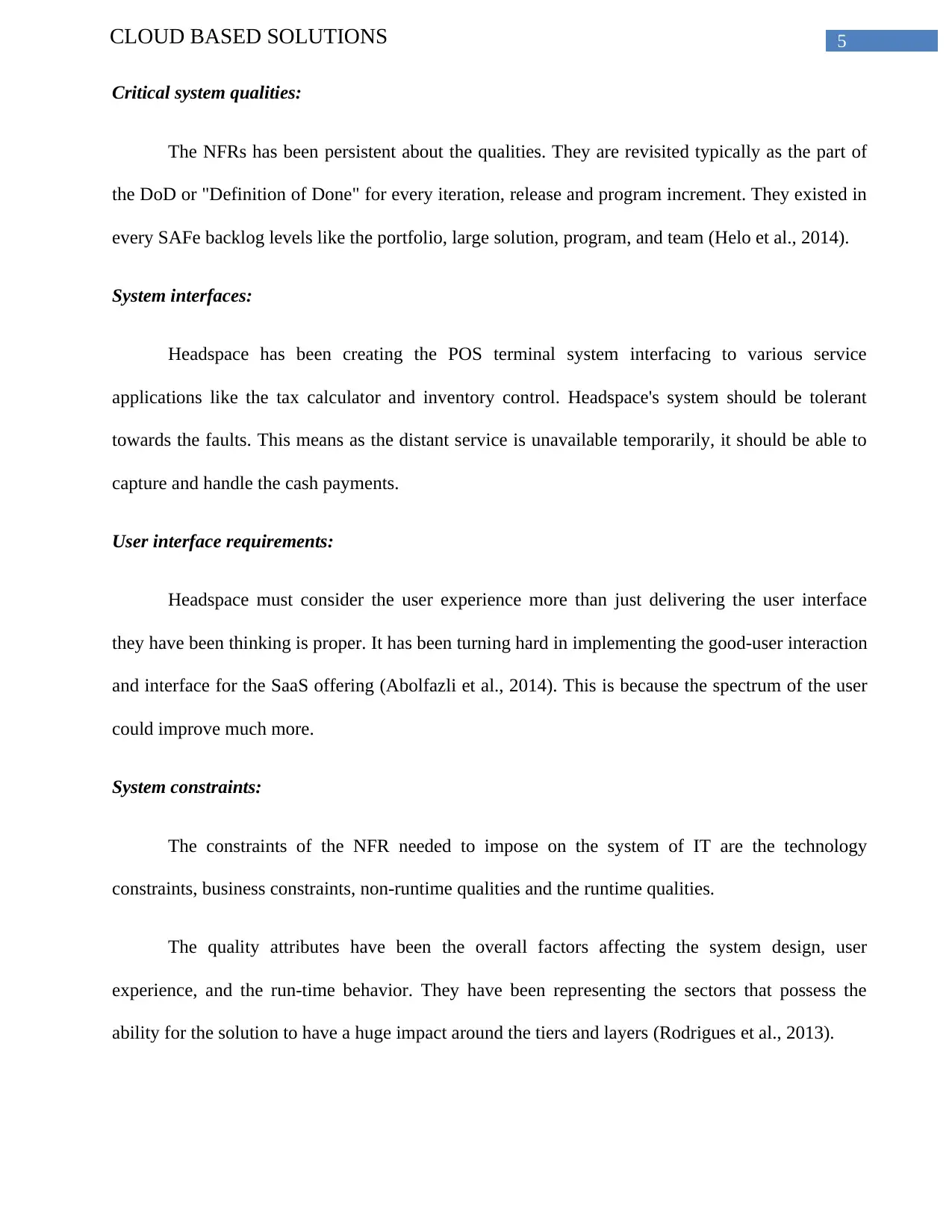
5CLOUD BASED SOLUTIONS
Critical system qualities:
The NFRs has been persistent about the qualities. They are revisited typically as the part of
the DoD or "Definition of Done" for every iteration, release and program increment. They existed in
every SAFe backlog levels like the portfolio, large solution, program, and team (Helo et al., 2014).
System interfaces:
Headspace has been creating the POS terminal system interfacing to various service
applications like the tax calculator and inventory control. Headspace's system should be tolerant
towards the faults. This means as the distant service is unavailable temporarily, it should be able to
capture and handle the cash payments.
User interface requirements:
Headspace must consider the user experience more than just delivering the user interface
they have been thinking is proper. It has been turning hard in implementing the good-user interaction
and interface for the SaaS offering (Abolfazli et al., 2014). This is because the spectrum of the user
could improve much more.
System constraints:
The constraints of the NFR needed to impose on the system of IT are the technology
constraints, business constraints, non-runtime qualities and the runtime qualities.
The quality attributes have been the overall factors affecting the system design, user
experience, and the run-time behavior. They have been representing the sectors that possess the
ability for the solution to have a huge impact around the tiers and layers (Rodrigues et al., 2013).
Critical system qualities:
The NFRs has been persistent about the qualities. They are revisited typically as the part of
the DoD or "Definition of Done" for every iteration, release and program increment. They existed in
every SAFe backlog levels like the portfolio, large solution, program, and team (Helo et al., 2014).
System interfaces:
Headspace has been creating the POS terminal system interfacing to various service
applications like the tax calculator and inventory control. Headspace's system should be tolerant
towards the faults. This means as the distant service is unavailable temporarily, it should be able to
capture and handle the cash payments.
User interface requirements:
Headspace must consider the user experience more than just delivering the user interface
they have been thinking is proper. It has been turning hard in implementing the good-user interaction
and interface for the SaaS offering (Abolfazli et al., 2014). This is because the spectrum of the user
could improve much more.
System constraints:
The constraints of the NFR needed to impose on the system of IT are the technology
constraints, business constraints, non-runtime qualities and the runtime qualities.
The quality attributes have been the overall factors affecting the system design, user
experience, and the run-time behavior. They have been representing the sectors that possess the
ability for the solution to have a huge impact around the tiers and layers (Rodrigues et al., 2013).
⊘ This is a preview!⊘
Do you want full access?
Subscribe today to unlock all pages.

Trusted by 1+ million students worldwide
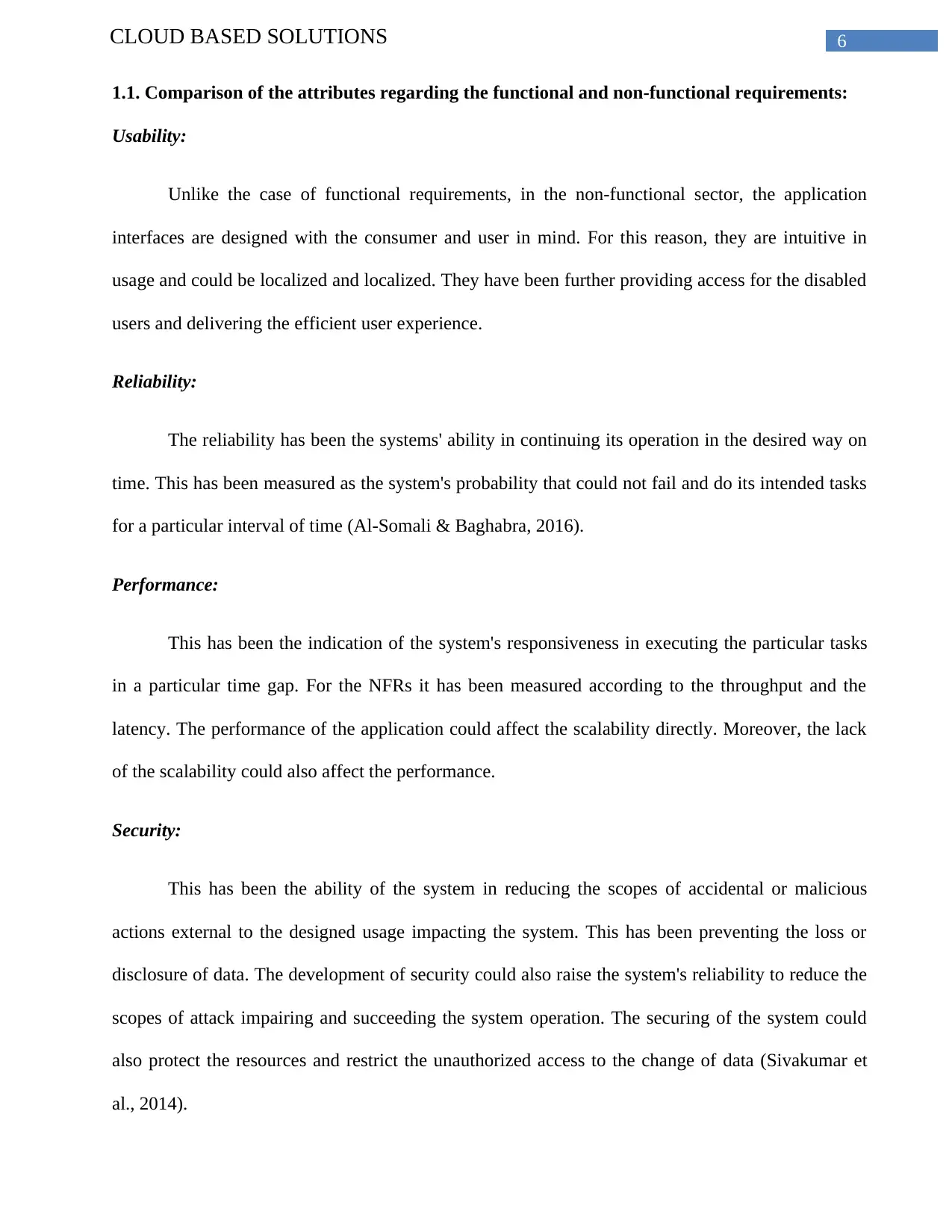
6CLOUD BASED SOLUTIONS
1.1. Comparison of the attributes regarding the functional and non-functional requirements:
Usability:
Unlike the case of functional requirements, in the non-functional sector, the application
interfaces are designed with the consumer and user in mind. For this reason, they are intuitive in
usage and could be localized and localized. They have been further providing access for the disabled
users and delivering the efficient user experience.
Reliability:
The reliability has been the systems' ability in continuing its operation in the desired way on
time. This has been measured as the system's probability that could not fail and do its intended tasks
for a particular interval of time (Al-Somali & Baghabra, 2016).
Performance:
This has been the indication of the system's responsiveness in executing the particular tasks
in a particular time gap. For the NFRs it has been measured according to the throughput and the
latency. The performance of the application could affect the scalability directly. Moreover, the lack
of the scalability could also affect the performance.
Security:
This has been the ability of the system in reducing the scopes of accidental or malicious
actions external to the designed usage impacting the system. This has been preventing the loss or
disclosure of data. The development of security could also raise the system's reliability to reduce the
scopes of attack impairing and succeeding the system operation. The securing of the system could
also protect the resources and restrict the unauthorized access to the change of data (Sivakumar et
al., 2014).
1.1. Comparison of the attributes regarding the functional and non-functional requirements:
Usability:
Unlike the case of functional requirements, in the non-functional sector, the application
interfaces are designed with the consumer and user in mind. For this reason, they are intuitive in
usage and could be localized and localized. They have been further providing access for the disabled
users and delivering the efficient user experience.
Reliability:
The reliability has been the systems' ability in continuing its operation in the desired way on
time. This has been measured as the system's probability that could not fail and do its intended tasks
for a particular interval of time (Al-Somali & Baghabra, 2016).
Performance:
This has been the indication of the system's responsiveness in executing the particular tasks
in a particular time gap. For the NFRs it has been measured according to the throughput and the
latency. The performance of the application could affect the scalability directly. Moreover, the lack
of the scalability could also affect the performance.
Security:
This has been the ability of the system in reducing the scopes of accidental or malicious
actions external to the designed usage impacting the system. This has been preventing the loss or
disclosure of data. The development of security could also raise the system's reliability to reduce the
scopes of attack impairing and succeeding the system operation. The securing of the system could
also protect the resources and restrict the unauthorized access to the change of data (Sivakumar et
al., 2014).
Paraphrase This Document
Need a fresh take? Get an instant paraphrase of this document with our AI Paraphraser
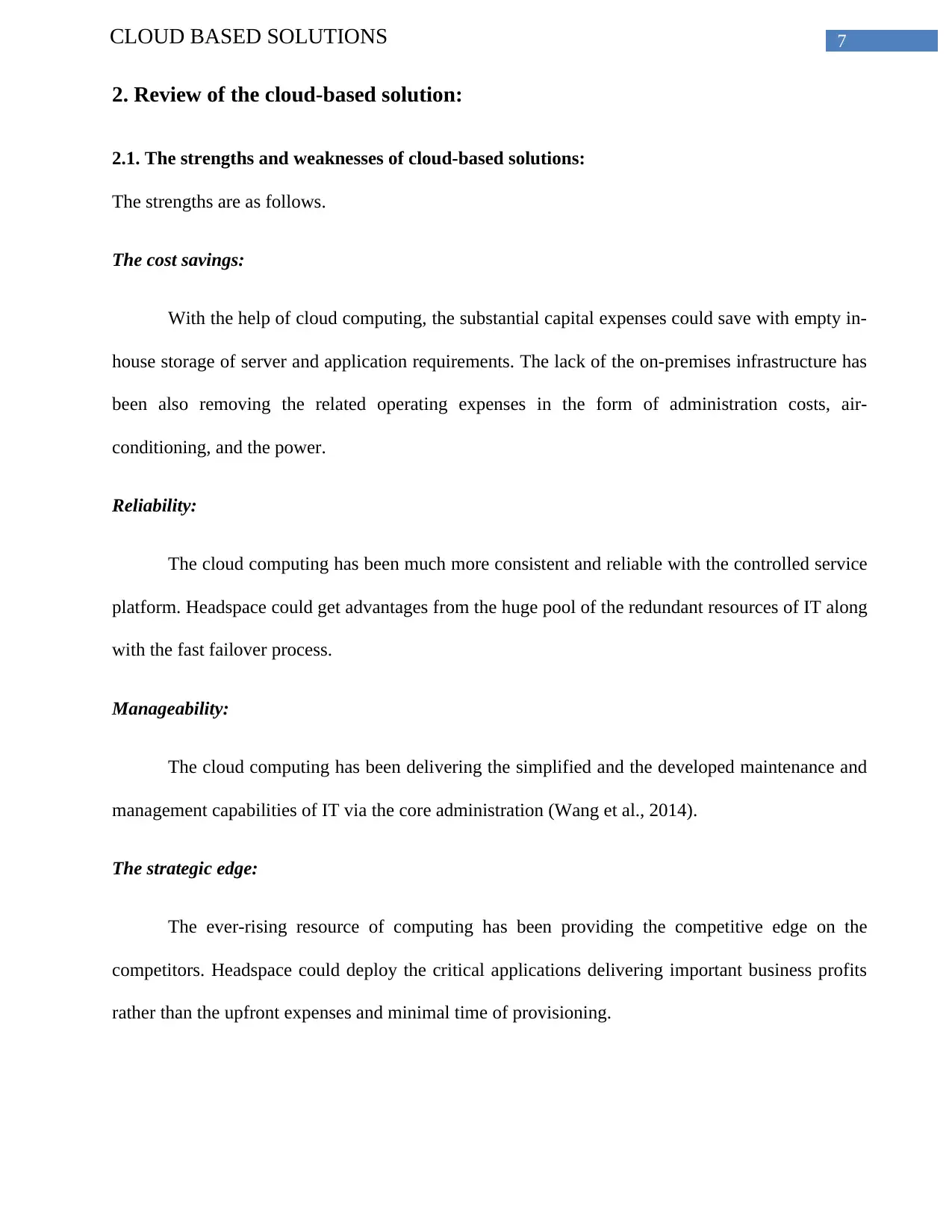
7CLOUD BASED SOLUTIONS
2. Review of the cloud-based solution:
2.1. The strengths and weaknesses of cloud-based solutions:
The strengths are as follows.
The cost savings:
With the help of cloud computing, the substantial capital expenses could save with empty in-
house storage of server and application requirements. The lack of the on-premises infrastructure has
been also removing the related operating expenses in the form of administration costs, air-
conditioning, and the power.
Reliability:
The cloud computing has been much more consistent and reliable with the controlled service
platform. Headspace could get advantages from the huge pool of the redundant resources of IT along
with the fast failover process.
Manageability:
The cloud computing has been delivering the simplified and the developed maintenance and
management capabilities of IT via the core administration (Wang et al., 2014).
The strategic edge:
The ever-rising resource of computing has been providing the competitive edge on the
competitors. Headspace could deploy the critical applications delivering important business profits
rather than the upfront expenses and minimal time of provisioning.
2. Review of the cloud-based solution:
2.1. The strengths and weaknesses of cloud-based solutions:
The strengths are as follows.
The cost savings:
With the help of cloud computing, the substantial capital expenses could save with empty in-
house storage of server and application requirements. The lack of the on-premises infrastructure has
been also removing the related operating expenses in the form of administration costs, air-
conditioning, and the power.
Reliability:
The cloud computing has been much more consistent and reliable with the controlled service
platform. Headspace could get advantages from the huge pool of the redundant resources of IT along
with the fast failover process.
Manageability:
The cloud computing has been delivering the simplified and the developed maintenance and
management capabilities of IT via the core administration (Wang et al., 2014).
The strategic edge:
The ever-rising resource of computing has been providing the competitive edge on the
competitors. Headspace could deploy the critical applications delivering important business profits
rather than the upfront expenses and minimal time of provisioning.
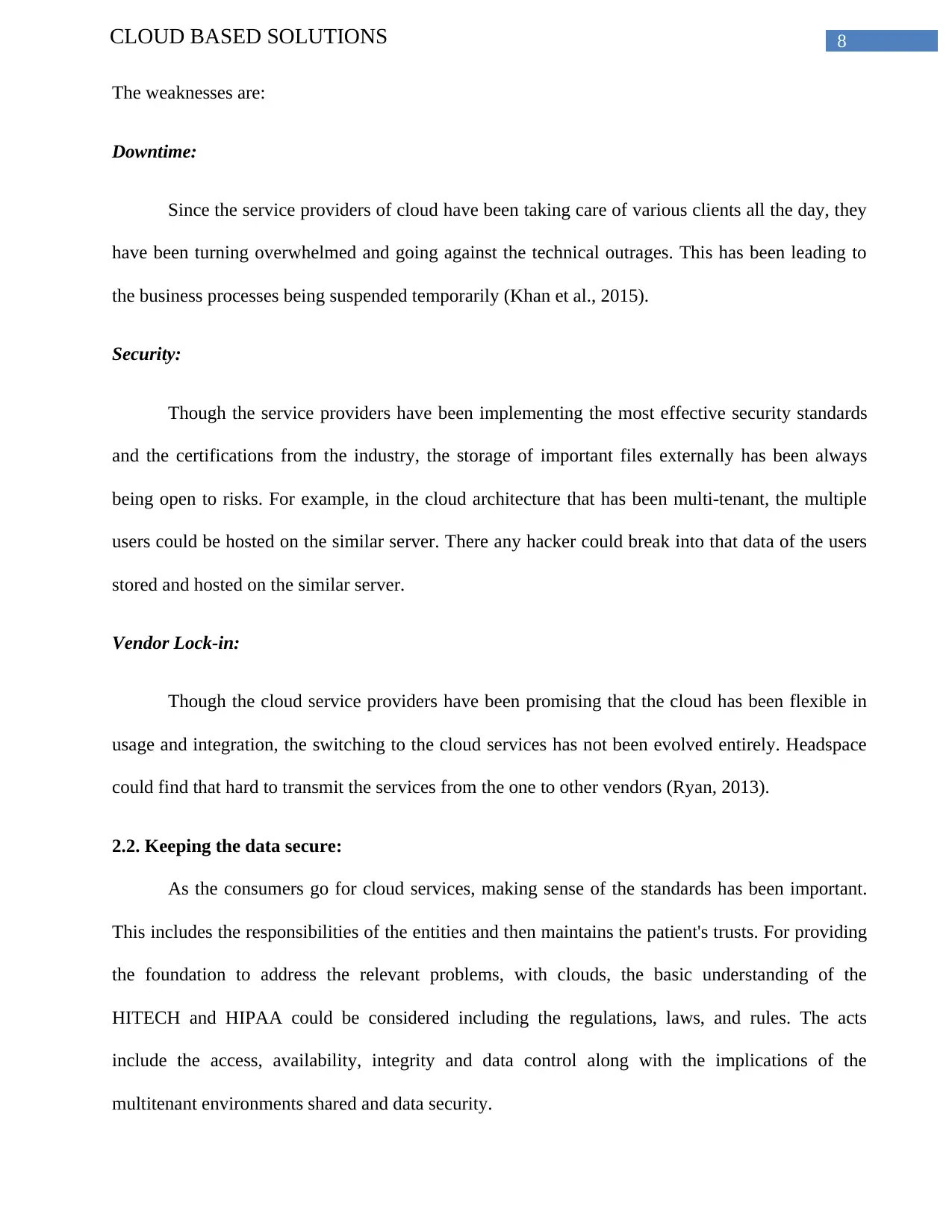
8CLOUD BASED SOLUTIONS
The weaknesses are:
Downtime:
Since the service providers of cloud have been taking care of various clients all the day, they
have been turning overwhelmed and going against the technical outrages. This has been leading to
the business processes being suspended temporarily (Khan et al., 2015).
Security:
Though the service providers have been implementing the most effective security standards
and the certifications from the industry, the storage of important files externally has been always
being open to risks. For example, in the cloud architecture that has been multi-tenant, the multiple
users could be hosted on the similar server. There any hacker could break into that data of the users
stored and hosted on the similar server.
Vendor Lock-in:
Though the cloud service providers have been promising that the cloud has been flexible in
usage and integration, the switching to the cloud services has not been evolved entirely. Headspace
could find that hard to transmit the services from the one to other vendors (Ryan, 2013).
2.2. Keeping the data secure:
As the consumers go for cloud services, making sense of the standards has been important.
This includes the responsibilities of the entities and then maintains the patient's trusts. For providing
the foundation to address the relevant problems, with clouds, the basic understanding of the
HITECH and HIPAA could be considered including the regulations, laws, and rules. The acts
include the access, availability, integrity and data control along with the implications of the
multitenant environments shared and data security.
The weaknesses are:
Downtime:
Since the service providers of cloud have been taking care of various clients all the day, they
have been turning overwhelmed and going against the technical outrages. This has been leading to
the business processes being suspended temporarily (Khan et al., 2015).
Security:
Though the service providers have been implementing the most effective security standards
and the certifications from the industry, the storage of important files externally has been always
being open to risks. For example, in the cloud architecture that has been multi-tenant, the multiple
users could be hosted on the similar server. There any hacker could break into that data of the users
stored and hosted on the similar server.
Vendor Lock-in:
Though the cloud service providers have been promising that the cloud has been flexible in
usage and integration, the switching to the cloud services has not been evolved entirely. Headspace
could find that hard to transmit the services from the one to other vendors (Ryan, 2013).
2.2. Keeping the data secure:
As the consumers go for cloud services, making sense of the standards has been important.
This includes the responsibilities of the entities and then maintains the patient's trusts. For providing
the foundation to address the relevant problems, with clouds, the basic understanding of the
HITECH and HIPAA could be considered including the regulations, laws, and rules. The acts
include the access, availability, integrity and data control along with the implications of the
multitenant environments shared and data security.
⊘ This is a preview!⊘
Do you want full access?
Subscribe today to unlock all pages.

Trusted by 1+ million students worldwide
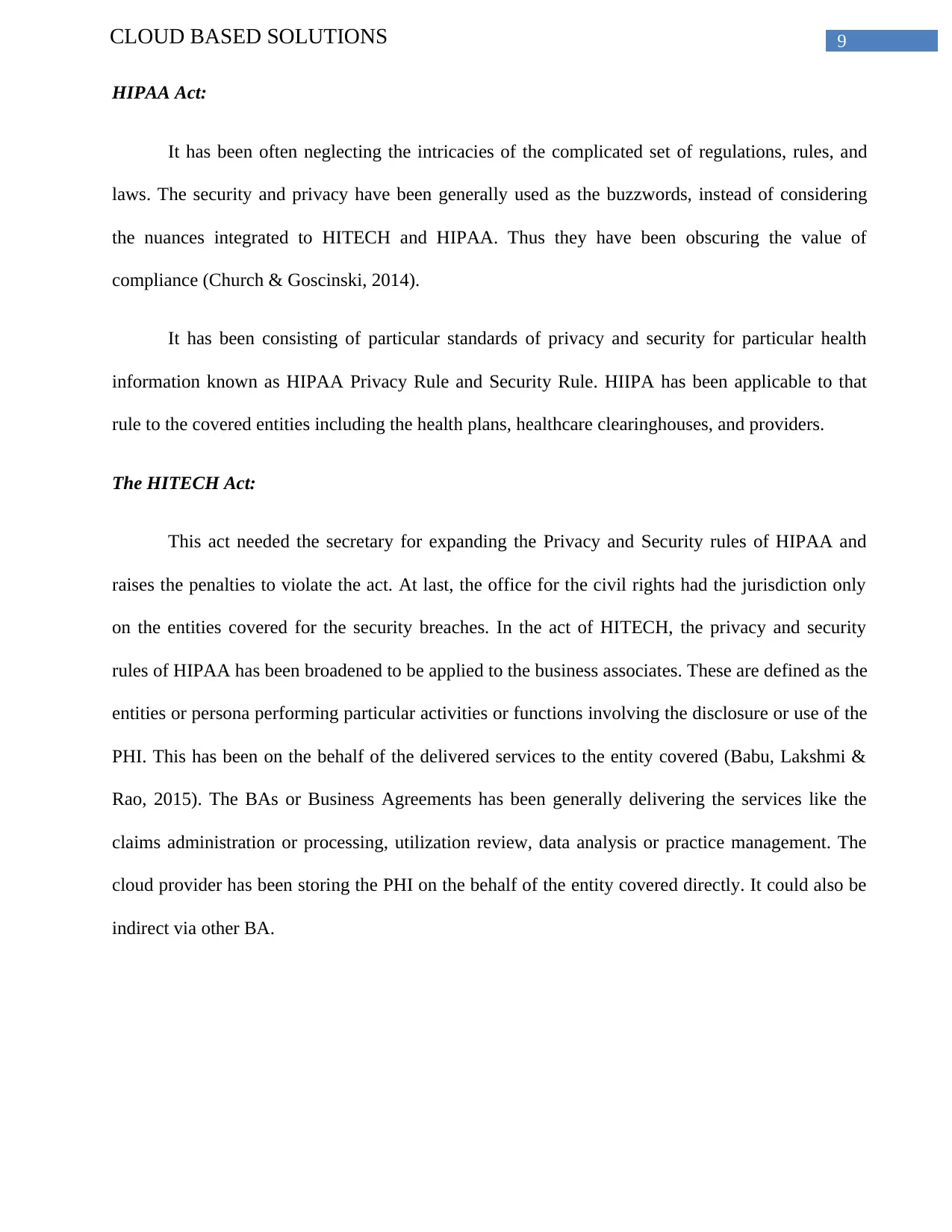
9CLOUD BASED SOLUTIONS
HIPAA Act:
It has been often neglecting the intricacies of the complicated set of regulations, rules, and
laws. The security and privacy have been generally used as the buzzwords, instead of considering
the nuances integrated to HITECH and HIPAA. Thus they have been obscuring the value of
compliance (Church & Goscinski, 2014).
It has been consisting of particular standards of privacy and security for particular health
information known as HIPAA Privacy Rule and Security Rule. HIIPA has been applicable to that
rule to the covered entities including the health plans, healthcare clearinghouses, and providers.
The HITECH Act:
This act needed the secretary for expanding the Privacy and Security rules of HIPAA and
raises the penalties to violate the act. At last, the office for the civil rights had the jurisdiction only
on the entities covered for the security breaches. In the act of HITECH, the privacy and security
rules of HIPAA has been broadened to be applied to the business associates. These are defined as the
entities or persona performing particular activities or functions involving the disclosure or use of the
PHI. This has been on the behalf of the delivered services to the entity covered (Babu, Lakshmi &
Rao, 2015). The BAs or Business Agreements has been generally delivering the services like the
claims administration or processing, utilization review, data analysis or practice management. The
cloud provider has been storing the PHI on the behalf of the entity covered directly. It could also be
indirect via other BA.
HIPAA Act:
It has been often neglecting the intricacies of the complicated set of regulations, rules, and
laws. The security and privacy have been generally used as the buzzwords, instead of considering
the nuances integrated to HITECH and HIPAA. Thus they have been obscuring the value of
compliance (Church & Goscinski, 2014).
It has been consisting of particular standards of privacy and security for particular health
information known as HIPAA Privacy Rule and Security Rule. HIIPA has been applicable to that
rule to the covered entities including the health plans, healthcare clearinghouses, and providers.
The HITECH Act:
This act needed the secretary for expanding the Privacy and Security rules of HIPAA and
raises the penalties to violate the act. At last, the office for the civil rights had the jurisdiction only
on the entities covered for the security breaches. In the act of HITECH, the privacy and security
rules of HIPAA has been broadened to be applied to the business associates. These are defined as the
entities or persona performing particular activities or functions involving the disclosure or use of the
PHI. This has been on the behalf of the delivered services to the entity covered (Babu, Lakshmi &
Rao, 2015). The BAs or Business Agreements has been generally delivering the services like the
claims administration or processing, utilization review, data analysis or practice management. The
cloud provider has been storing the PHI on the behalf of the entity covered directly. It could also be
indirect via other BA.
Paraphrase This Document
Need a fresh take? Get an instant paraphrase of this document with our AI Paraphraser
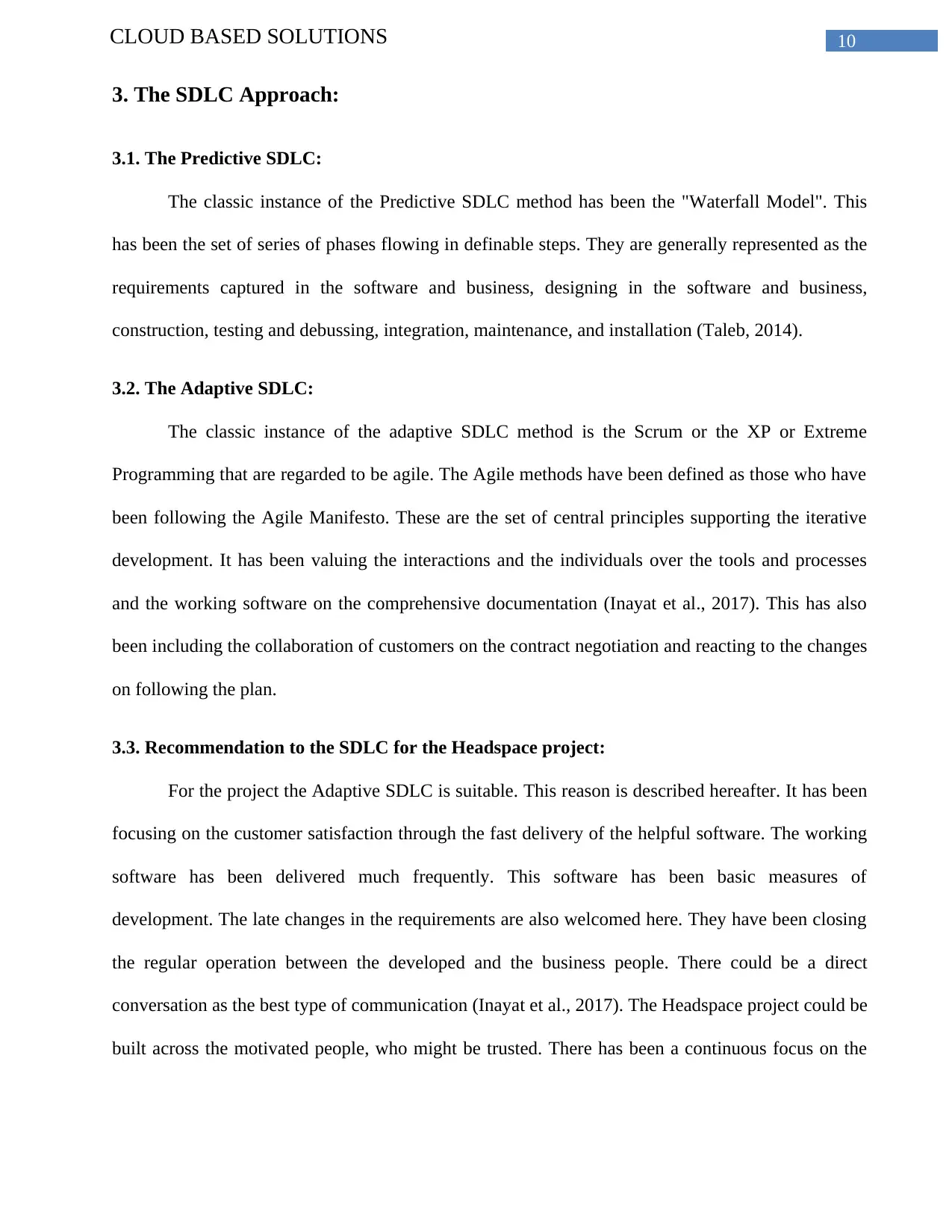
10CLOUD BASED SOLUTIONS
3. The SDLC Approach:
3.1. The Predictive SDLC:
The classic instance of the Predictive SDLC method has been the "Waterfall Model". This
has been the set of series of phases flowing in definable steps. They are generally represented as the
requirements captured in the software and business, designing in the software and business,
construction, testing and debussing, integration, maintenance, and installation (Taleb, 2014).
3.2. The Adaptive SDLC:
The classic instance of the adaptive SDLC method is the Scrum or the XP or Extreme
Programming that are regarded to be agile. The Agile methods have been defined as those who have
been following the Agile Manifesto. These are the set of central principles supporting the iterative
development. It has been valuing the interactions and the individuals over the tools and processes
and the working software on the comprehensive documentation (Inayat et al., 2017). This has also
been including the collaboration of customers on the contract negotiation and reacting to the changes
on following the plan.
3.3. Recommendation to the SDLC for the Headspace project:
For the project the Adaptive SDLC is suitable. This reason is described hereafter. It has been
focusing on the customer satisfaction through the fast delivery of the helpful software. The working
software has been delivered much frequently. This software has been basic measures of
development. The late changes in the requirements are also welcomed here. They have been closing
the regular operation between the developed and the business people. There could be a direct
conversation as the best type of communication (Inayat et al., 2017). The Headspace project could be
built across the motivated people, who might be trusted. There has been a continuous focus on the
3. The SDLC Approach:
3.1. The Predictive SDLC:
The classic instance of the Predictive SDLC method has been the "Waterfall Model". This
has been the set of series of phases flowing in definable steps. They are generally represented as the
requirements captured in the software and business, designing in the software and business,
construction, testing and debussing, integration, maintenance, and installation (Taleb, 2014).
3.2. The Adaptive SDLC:
The classic instance of the adaptive SDLC method is the Scrum or the XP or Extreme
Programming that are regarded to be agile. The Agile methods have been defined as those who have
been following the Agile Manifesto. These are the set of central principles supporting the iterative
development. It has been valuing the interactions and the individuals over the tools and processes
and the working software on the comprehensive documentation (Inayat et al., 2017). This has also
been including the collaboration of customers on the contract negotiation and reacting to the changes
on following the plan.
3.3. Recommendation to the SDLC for the Headspace project:
For the project the Adaptive SDLC is suitable. This reason is described hereafter. It has been
focusing on the customer satisfaction through the fast delivery of the helpful software. The working
software has been delivered much frequently. This software has been basic measures of
development. The late changes in the requirements are also welcomed here. They have been closing
the regular operation between the developed and the business people. There could be a direct
conversation as the best type of communication (Inayat et al., 2017). The Headspace project could be
built across the motivated people, who might be trusted. There has been a continuous focus on the
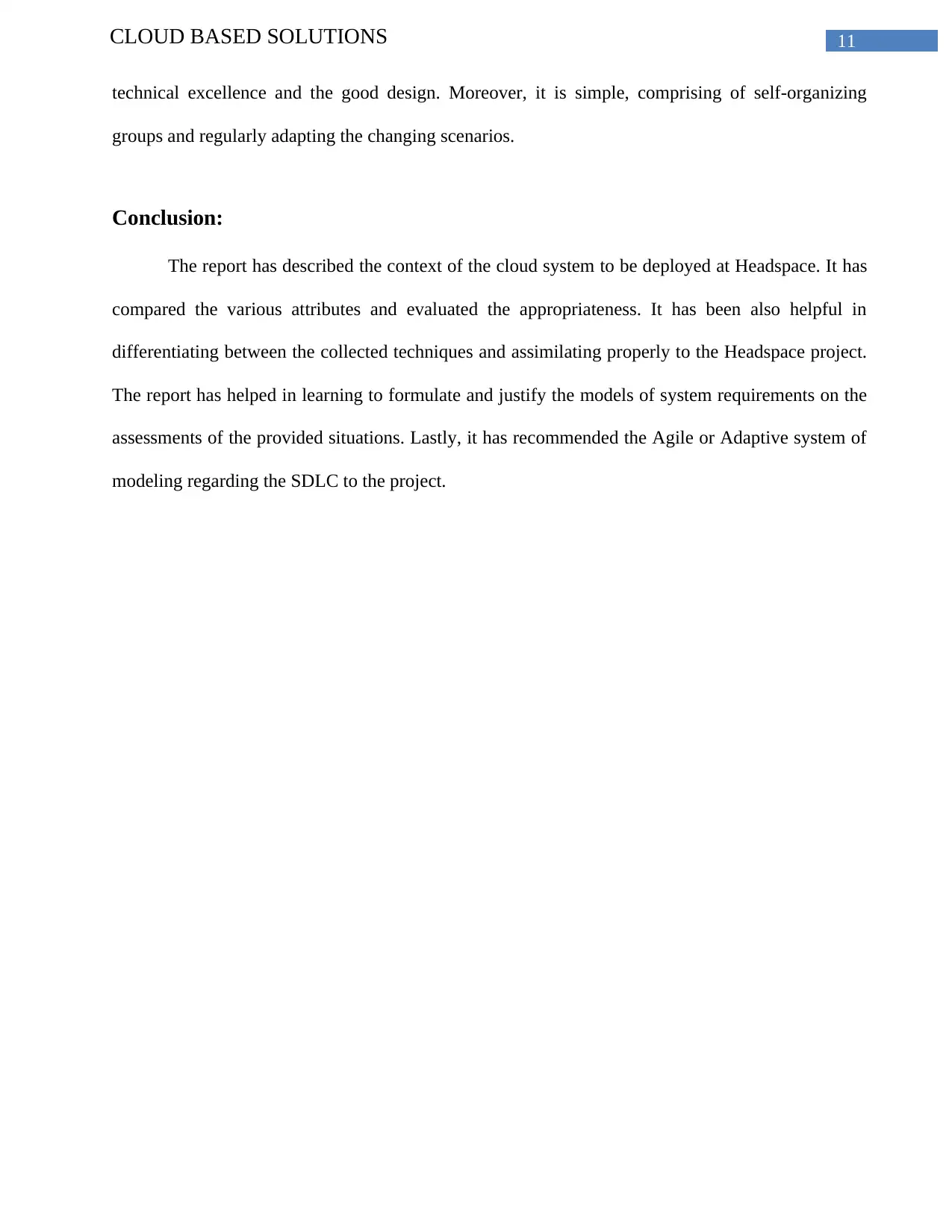
11CLOUD BASED SOLUTIONS
technical excellence and the good design. Moreover, it is simple, comprising of self-organizing
groups and regularly adapting the changing scenarios.
Conclusion:
The report has described the context of the cloud system to be deployed at Headspace. It has
compared the various attributes and evaluated the appropriateness. It has been also helpful in
differentiating between the collected techniques and assimilating properly to the Headspace project.
The report has helped in learning to formulate and justify the models of system requirements on the
assessments of the provided situations. Lastly, it has recommended the Agile or Adaptive system of
modeling regarding the SDLC to the project.
technical excellence and the good design. Moreover, it is simple, comprising of self-organizing
groups and regularly adapting the changing scenarios.
Conclusion:
The report has described the context of the cloud system to be deployed at Headspace. It has
compared the various attributes and evaluated the appropriateness. It has been also helpful in
differentiating between the collected techniques and assimilating properly to the Headspace project.
The report has helped in learning to formulate and justify the models of system requirements on the
assessments of the provided situations. Lastly, it has recommended the Agile or Adaptive system of
modeling regarding the SDLC to the project.
⊘ This is a preview!⊘
Do you want full access?
Subscribe today to unlock all pages.

Trusted by 1+ million students worldwide
1 out of 13
Related Documents
Your All-in-One AI-Powered Toolkit for Academic Success.
+13062052269
info@desklib.com
Available 24*7 on WhatsApp / Email
![[object Object]](/_next/static/media/star-bottom.7253800d.svg)
Unlock your academic potential
Copyright © 2020–2025 A2Z Services. All Rights Reserved. Developed and managed by ZUCOL.





